Stress and Strain - Definition, Curve, Hooke's Law, SI Units, Types, FAQs
Stress and strain are fundamental concepts in physics and engineering that describe how materials respond to external forces. Stress refers to the internal force per unit area within a material, caused by an applied load, while strain is the deformation or displacement that occurs as a result of this stress. These principles aren't just theoretical but have practical applications in everyday life. For example, when we apply pressure on a rubber band (stress), it stretches (strain). Similarly, the way a bridge or building bends or flexes under the weight of vehicles or wind is a real-life demonstration of stress and strain. Understanding these concepts helps engineers design safe structures and products that can withstand various forces without breaking or deforming. Even in our bodies, bones and muscles experience stress and strain during physical activities like running or lifting, making these ideas crucial in biomechanics and medical science.
New: JEE Main/NEET 2027 - Physics Important Formulas for Class 10
JEE Main 2025: Study Materials | High Scoring Topics | Preparation Guide
JEE Main 2025: Syllabus | Sample Papers | Mock Tests | PYQs | Study Plan 100 Days
NEET 2025: Syllabus | High Scoring Topics | PYQs | Crack NEET in 2 months - Study Plan
- Elastic or Deforming Force
- What is Stress?
- Types of Stress
- What is Strain?
- Hooke's Law
- Types of Modulus of Elasticity

Elastic or Deforming Force
It is the applied force onto a body by which its shape or size changes over time, the change can be in length, breadth volume or change on all three of these. That is there will be a change in the normal shape of the molecule implying that there is a change in the arrangement of molecules.
Elasticity
It is the special ability of a body to regain its initial original configuration on the removal of the deforming force. Those materials showing the elastic property are called elastic materials. The more elastic the material is faster it can turn back into its original state.
Examples of elastic materials are quartz fibre. phosphor bronze, etc
Plasticity
It is the inability of a body to regain its original status on the removal of the deforming forces, the objects or materials that obey the plasticity property are called plastic materials
Examples of materials that show plasticity or plastic materials are - bakelite, plastic etc.
What is Stress?
The restoring force or deforming force experienced per unit area on a body is called stress. It has the dimension of force per area or the same dimension as that of pressure.
Stress $=\frac{\text { Force }}{\text { Area }}$
$
1 \mathrm{~N} / \mathrm{m}^2=1 \mathrm{~Pa}(\text { pascal })
$
The SI unit of stress is pascal ( Pa ).
Types of Stress
Usually, stress is classified into four types of stress depending on the way in which the stress is applied: they are Normal stress, tensile stress, compressive stress, and Tangential stress.
1. Normal Stress
Normal stress occurs when the elastic restoring force or deforming force operates perpendicular to the region. The following are some of the most common types of normal stress.
A. Tensile Stress
The stress developed inside the body is called tensile stress when the length of the body increases In the direction of the applied force.
Here in the below image, you can see that when the force is applied in a particular direction the length of the body increases in the same direction as that of the applied force.

B. Compressive Stress
The stress developed inside the body is called compressive stress when the length of the body decreases in the direction of the force applied.
Here in the figure below you can see that the length of the body decreases in the direction of the applied force.

-
Tangential or Shearing Stress
Tangential stress occurs when an elastic restoring force or deforming force operates parallel to the surface area. Here in the figure below you can see that the force is applied along a surface and it is called tangential because the force is not perpendicularly applied rather it is applied tangentially to the surface.

What is Strain?
The strain has several meanings in literature here we are going to look at what is strain in physics. Strain definition can be made as it is a fraction which compares the change in the configuration of the body to the original configuration or the initial configuration of the body. Since the numerator and denominator of the term have the same dimension they cancel out each other and hence strain in a dimensionless quantity.
Strain =Change in configuration original configuration
There are different types of strains discussed below
Depending on the surface of the applied force and the change in the shape of the objects, strains can be classified as three – Longitudinal strain, volumetric strain, and shearing strain.
-
Longitudinal Strain
It is the relation between the change in length and the original length of the body where force is applied. This type of strain is calculated in the case where the deforming force is acting perpendicular to the surface
Longitudinal Strain =Change in length/Original length
-
Volumetric Strain
It has the same definition as that of the strain but here the force acting on the body from all directions not only causes the change in length but totally the entire volume is changed. So it can be written as the ratio of change in volume of the body to the original volume.
Volumetric Strain = Change in volume/Original volume
3. Shearing Strain
A tangential force causes a plane perpendicular to the fixed surface of the cubical body to turn via an angle (in radians).

Stress vs strain curve or stress-strain diagram or stress-strain curve for brittle material

Hooke's Law
In the case of small deformations that is when the applied force is small but it should be enough to cause deformations, in such conditions the stress acting on the body is directly proportional to the strain, which can be seen in the above stress and strain curve. It is also called stress-strain theory.
Stress $\propto$ Strain
Stress $=k \cdot$ Strain
Where, K is the proportionality constant, and is known as the modulus of elasticity, in the above stress-strain curve diagram, the region that obeys Hooke’s law is called Hooke” 's law curve.
Elastic Moduli: Modulus of elasticity - According to Hooke's law, within clastic limit stress is directly proportional to the strain, which can be seen in the stress-strain graph above. Which implies
Stress $\propto$ Strain
Stress $=E \cdot$ Strain
$\frac{\text { Stress }}{\text { Strain }}$ is constant for elastic deformations.
Where E is known as the modulus of elasticity or elastic moduli, the ratio of stress and strain is known as the modulus of elasticity, there are different kinds of modulus of elasticity according to the type of stress and strain which is discussed below
Types of Modulus of Elasticity
- Young's Modulus of Elasticity (Y)
When the force acted is normal to the surface the stress and strain will be normal and hence its proportionality constant is discussed here as Young’s modulus
Y = Normal stress/Longitudinal strain
- Bulk modulus of elasticity (B)
The bulk modulus is the ratio of normal stress to the volumetric strain.
B = Normal stress/Volumetric strain
Its Unit is - Nm or Pascal
Compressibility (A) - Reciprocal of bulk modulus of elasticity (B)
- Modulus of Rigidity or shear modulus of elasticity (G)
When the deforming force is acting shear to the surface or tangential surface the stress and strain developed will be shear strain and tangential stress. The proportionality constant in this case is called the rigidity modulus or the shear modulus.
G = Tangential stress/Shearing strain
Recommended Topic Video
Frequently Asked Questions (FAQs)
When a deforming force is applied on a body then the deforming force acting per unit area is called stress and change in the configuration to the original configuration is called strain.
It is the graph that plots stress on y axis and strain on x axis which conveys how the stress on the body changes with respect to the strain applied. It has several regions called Hooke’s region, yield limit, plastic region etc.
Strain =Change in configuration/Original configuration
Stress = Force/Area
And Hookes law states that within elastic limits,
Stress α Strain
Unit of stress is Newton per meter square but strain do not have any unit, is just a number. That is it is a dimensionless quantity
It is the reciprocal of volumetric strain so it can be referred to as the ratio of original volume to the change in volume.
Also Read
02 Dec'24 12:36 AM
20 Nov'24 10:36 AM
19 Nov'24 01:38 PM
17 Nov'24 10:04 AM
12 Nov'24 11:53 PM
12 Nov'24 10:14 PM
12 Nov'24 09:30 PM
12 Nov'24 02:20 AM
12 Nov'24 02:19 AM